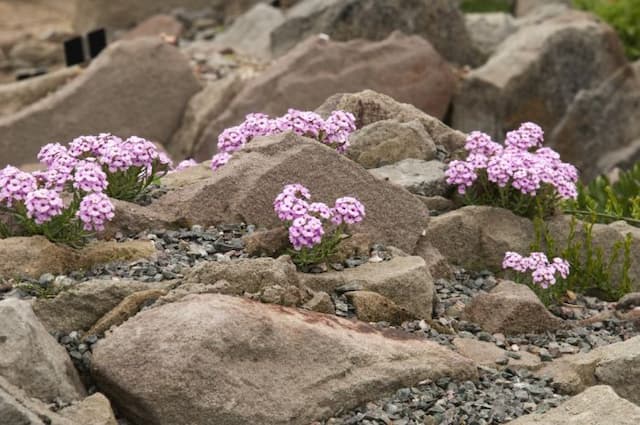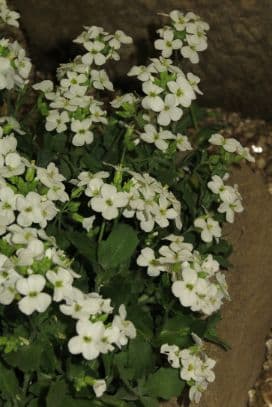Wallflower Erysimum linifolium Stars 'n' Stripes = 'Yastrip' (PBR) (v)
![wallflower [Stars 'n' Stripes]](/_next/image?url=https%3A%2F%2Fplants-admin.emdemapps.com%2Fimages%2Fplants%2F%2Fimages%2F604b5cc04bf7a.png&w=3840&q=75)
ABOUT
Erysimum linifolium Stars 'n' Stripes, commonly known as wallflower, boasts a striking appearance characterized by its vibrant and variegated foliage, which typically features a blend of green and creamy yellow stripes. This colorful pattern grants it the 'Stars 'n' Stripes' name, as it is reminiscent of a flag's stirring design. Complementing its eye-catching leaves, the wallflower produces an abundance of flowers that add to its ornamental charm. These blossoms come in a riot of colors which may include shades of purple, orange, and yellow, creating a vivid display that is both striking and cheerful. The vibrant flowers are often densely clustered, providing a rich visual texture and a pleasing contrast against the boldly patterned leaves. The combination of its distinctive foliage and the profusion of brightly colored blooms makes this wallflower a distinctive and attractive addition to any garden display.
About this plant
 Names
NamesSynonyms
Variegated Wallflower, Stars 'n' Stripes Wallflower, Striped Perennial Wallflower
Common names
Erysimum linifolium
 Toxicity
ToxicityTo humans
The Erysimum linifolium variety 'Stars 'n' Stripes' is commonly known as Perennial Wallflower. Generally, Perennial Wallflowers are not known to be toxic to humans. However, it is always advisable to avoid ingesting plants that are not specifically grown for consumption, as they may cause discomfort or an allergic reaction in sensitive individuals. If symptoms do occur after ingesting any part of the plant, they may include mild gastrointestinal upset, though there is no specific record of toxicity for this plant regarding humans.
To pets
Perennial Wallflower, the common name for Erysimum linifolium 'Stars 'n' Stripes', is not typically listed as a toxic plant to pets. Although most Erysimum species are not known for being poisonous to animals, caution is still recommended since sensitivity to plants can vary among different pets. If a pet ingests part of this plant, they could potentially experience mild gastrointestinal upset, but severe toxicity is unlikely. Always monitor your pet's response to new plants and contact a veterinarian if any unusual symptoms arise.
 Characteristics
CharacteristicsLife cycle
Perennials
Foliage type
Evergreen
Color of leaves
Variegated
Flower color
Mixed
Height
1 feet 6 inches (45 cm)
Spread
1 feet 6 inches (45 cm)
Plant type
Shrub
Hardiness zones
7
Native area
Europe
Benefits
 General Benefits
General Benefits- Attractive Flowering - Produces vibrant and colorful flowers that can enhance the visual appeal of any garden or landscape.
- Long Blooming Period - Offers an extended period of blooming compared to many other plants, often throughout the spring and summer months.
- Drought Tolerance - Once established, it has a good level of drought resistance, making it suitable for drier climates or water-wise gardens.
- Low Maintenance - Requires minimal care beyond basic watering and occasional pruning, making it ideal for gardeners of all levels.
- Cold Hardy - Able to withstand cooler temperatures, which makes it a suitable choice for gardens in temperate regions.
- Attracts Pollinators - Flowers attract bees, butterflies, and other beneficial insects, supporting local ecosystems.
- Deer Resistant - This plant is not preferred by deer, reducing the chances of damage in areas where deer may be a problem.
- Compact Growth - Its growth habit is relatively compact, making it a good fit for smaller gardens or as a border plant.
- Versatility - Can be used in a variety of garden styles, including rockeries, borders, and containers.
- Evergreen Foliage - Retains its leaves throughout the year, providing ongoing interest even when not in bloom.
 Medical Properties
Medical PropertiesThis plant is not used for medical purposes.
 Air-purifying Qualities
Air-purifying QualitiesThis plant is not specifically known for air purifying qualities.
 Other Uses
Other Uses- Natural Dye: The petals of the plant can be used to create a natural dye for fabrics or paper, providing a range of colors depending on the mordant used.
- Photography: The vibrant patterns of the Erysimum 'Bowles's Mauve' make it an excellent subject for macro photography and botanical art.
- Educational Tool: The plant can be used in educational settings to teach about pollination, plant biology, and the importance of plant-insect interactions.
- Garden Design: 'Bowles's Mauve' can be used in garden design to teach principles of color theory and landscape aesthetics due to its striking appearance.
- Companion Planting: In the vegetable garden, it can serve as a companion plant, attracting pollinators that can increase the yield of crops.
- Crafts: Dried flowers of Erysimum 'Bowles's Mauve' can be used in making bookmarks, greeting cards, or pressed flower arrangements.
- Scented Sachets: The plant's leaves can be dried and used in scented sachets to freshen up drawers and wardrobes with a mild, herbaceous fragrance.
- Food Presentation: Edible varieties of Erysimum flowers can be used as a decorative and edible garnish on salads and desserts to enhance the visual appeal of dishes.
- Symbolic Gifts: Due to their beauty and perennial nature, they can be given as gifts to symbolize enduring affection or friendship.
- Holiday Decor: During the holiday seasons, branches and flowers can be incorporated into wreaths and table arrangements for a natural touch.
Interesting Facts
 Feng Shui
Feng ShuiThe plant Erysimum 'Bowles's Mauve' is not used in Feng Shui practice.
 Zodiac Sign Compitability
Zodiac Sign CompitabilityThe plant Erysimum 'Bowles's Mauve' is not used in astrology practice.
 Plant Symbolism
Plant SymbolismErysimum linifolium Stars 'n' Stripes is more commonly known as Wallflower. Here is the symbolic meaning in HTML format:
- Perseverance: The wallflower thrives in tough conditions, symbolizing the ability to endure and persist.
- Adversity: Growing well even in poor soil, the wallflower represents overcoming difficult situations.
- Faithfulness: With its long blooming season, wallflowers symbolize loyalty and steadfastness.
- Humility: As a plant that does not dominate the landscape, wallflowers are associated with modesty and discretion.
 Water
WaterThe Wallflower 'Bowles's Mauve' requires regular watering, especially during dry periods. It is best to water the plant deeply once a week, providing about a gallon of water per session to ensure the soil becomes thoroughly moistened. The goal is to encourage a strong root system, so allowing the top inch of soil to dry out between waterings is ideal. Be mindful to avoid overwatering as this can lead to root rot. Adjust the watering frequency to account for rainfall and changes in temperature that may affect the plant's water needs.
 Light
LightWallflower 'Bowles's Mauve' thrives in full sun to partial shade conditions. The ideal spot for this plant would be an area that receives at least 6 hours of direct sunlight per day. However, in regions with very hot summers, providing some afternoon shade will protect the plant from excessive heat.
 Temperature
TemperatureWallflower 'Bowles's Mauve' does best in moderate temperature conditions, generally between 50°F and 75°F. It can tolerate minimum temperatures down to about 20°F when established. This plant prefers a cooler climate and may struggle in areas where the temperature rises above 80°F for extended periods.
 Pruning
PruningPruning Wallflower 'Bowles's Mauve' is important to promote bushy growth and prolong the flowering period. Prune the plant lightly after each flush of blooms to encourage new growth. The best time for pruning is immediately after the main flowering season, although regular deadheading can be done throughout the season to maintain the plant's appearance.
 Cleaning
CleaningAs needed
 Soil
SoilBowles' Mauve wallflower prefers well-draining soil with a neutral to slightly alkaline pH, typically around 7.0 to 7.5. A good mix would be equal parts loam, sand, and peat for adequate aeration and drainage.
 Repotting
RepottingBowles' Mauve should be repotted every 2 to 3 years to refresh the soil and accommodate root growth, typically in spring or after flowering.
 Humidity & Misting
Humidity & MistingBowles' Mauve thrives in average humidity conditions and does not require any special humidity adjustments.
 Suitable locations
Suitable locationsIndoor
Place in bright light, avoid overwatering, and ensure good airflow.
Outdoor
Plant in full sun, well-draining soil, and shield from harsh winds.
Hardiness zone
7-9 USDA
 Life cycle
Life cycleErysimum linifolium 'Bowles's Mauve', commonly known as wallflower, starts its life as a seed, which upon germination emerges as a small seedling with basic root structure and cotyledon leaves. As it matures, it forms a dense bush of narrow, grey-green leaves and becomes a flowering perennial with long-lasting, mauve flowers that showcase stripes of deep purple and yellow, attracting pollinators such as bees and butterflies. After pollination, the flowers develop into elongated seed pods containing numerous small seeds, which upon maturity, disperse to grow new plants. During its life, it may experience vegetative propagation through cuttings, facilitating gardeners to clone and extend the life of desirable traits. The plant typically reaches peak vegetative growth and flowering in spring and summer, with a bloom period extending into autumn in milder climates. Finally, after several years - as the plant is a short-lived perennial - it will eventually exhaust its life cycle, though self-seeding or cuttings can perpetuate its presence in the garden.
 Propogation
PropogationPropogation time
Spring to Summer
The Erysimum linifolium 'Stars 'n' Stripes', commonly known as ‘Bowles’s Mauve’, is best propagated through softwood cuttings. The optimal time to take these cuttings is during late spring or early summer when the plant is actively growing. To propagate, select a healthy, non-flowering shoot and make a cut to create a segment about 3-4 inches (approximately 7.5-10 centimeters) long, just below a leaf node. Remove the lower leaves, and dip the cutting end into rooting hormone powder to encourage root growth. Plant the cutting in a well-draining soil mix, and keep it moist and in a warm location with indirect sunlight. Roots usually develop in a few weeks, after which the new plant can eventually be transplanted outdoors. This method is widely used due to its simplicity and effectiveness in producing new plants that are true to the parent's characteristics.



![Aubrieta [Axcent Light Blue]](/_next/image?url=https%3A%2F%2Fplants-admin.emdemapps.com%2Fimages%2Fplants%2F%2Fimages%2F604b5e7128866.png&w=640&q=75)





